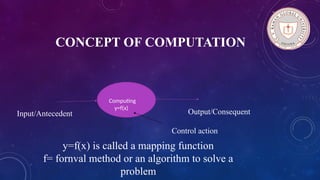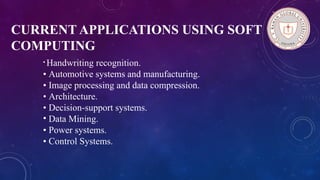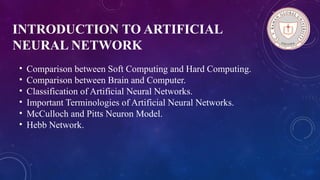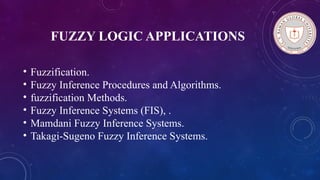Intro to Soft Computing with a focus on AI
- 1. SOFT COMPUTING PRESENTED BY:-SUSHREE SAMIKSHYA PATTANAIK C.V.RAMAN GLOBAL UNIVERSITY,BHUBANESWAR
- 2. COURSE OBJECTIVES To understand neural network, Fuzzy logic and Genetic Algorithm.
- 3. SYLLABUS Unit 1 Introduction to Artificial Neural Network Unit 2 Supervised and Unsupervised Learning Methods Unit 3 Fuzzy Logic Unit 4 Fuzzy Logic Applications Unit 5 Takagi-Sugeno Fuzzy Inference Systems, Hybrid Techniques – Neuro Fuzzy System
- 4. COURSE OUTCOME CO1: To study the characteristics of biological neurons, perceptron models and algorithms. CO2: To study the modelling of non-linear systems using ANN. CO3: To learn the fuzzy set theories, its operation. CO4: To apply the knowledge of fuzzy logic for modelling systems. CO5: To apply the knowledge of GA and PSO.
- 5. TEXT BOOKS/REFERENCE BOOKS T1. S.N. Sivanandam, S.N. Deepa , “ Principles of Soft Computing”, Second Edition, Wiley India, 2011. T2. N.P. Padhy, S.P. Simon, “Soft Computing with MATLAB Programming”, OXFORD University Press, 2015. T3. S. Rajasekaran, G.A. Vijaylakshmi Pai, “Neural Network, Fuzzy Logic, and Genetic Algorithms – Synthesis and Applications”, PHI Learning Private Limited. R1. Laurence Fausett, “Fundamentals of Neural Networks”, Prentice Hall, Englewood Cliffs,N.J., 1992. R2. Timothy J. Ross, “Fuzzy Logic with Engineering Applications”, McGraw Hill Inc., 1997. R3. Goldberg, “Genetic Algorithm in Search, Optimization and Machine learning”, Addison Wesley Publishing Company Inc. 1989. R4. Simon Haykin, “ Neural Networks and Learning Machines”, Third Edition, Pearson –Prentice Hall
- 6. CONCEPT OF COMPUTATION Input/Antecedent Output/Consequent y=f(x) is called a mapping function f= fornval method or an algorithm to solve a problem Computing y=f(x) Control action
- 7. IMPORTANT CHARACTERISTICS OF SOFT COMPUTING • Should provide precise solution. • Control action should unambiguous and accurate. • Suitable for problem, which is easy to model mathematically.
- 8. CHARACTERISTICS OF SOFT COMPUTING • It does not required any mathematical modeling of problem solving. • It may not yield the precise solution. • Algorithms are adaptive (i.e., it can adjust to the change of dynamic environment). • Use some biological inspired methodologies such as genetics, evolution, ant’s behaviors ,particles swarming ,human nervous system , etc.
- 9. cat cut knowledge Animal? cat Neural character recognition SOFT COMPUTING Animal character recognition
- 10. HOW SOFT COMPUTING? How a doctor treats his patient? • Doctor asks the patient about suffering. • Doctor find the symptoms of diseases. • Doctor prescribed tests and medicines. This is exactly the way fuzzy logic works. • Symptoms are correlated with diseases with uncertainty. • Doctor prescribes tests/medicines fuzzily.
- 11. DIFFERENCE BETWEEN HARD AND SOFT COMPUTING Hard Computing • It requires a precisely stated analytical model and often a set of computation time. • It is based on binary logic, crisp system, neural analysis and crisp software. • It has the characteristics of precision and categoricity • Deterministic • Requires exact input data • Strictly sequential • Produces precise answer Soft Computing • It is tolerant of imprecision uncertainty, partial truth and approximation. • It is based on fuzzy logic, neural networks, probabilistic reasoning etc. • It has the characteristics of approximation and disposition ability. • Stochastics.(random probability distribution or pattern that may be analyzed statically) • Can deal with ambiguous and noisy data • Parallel computations • Yields approximation answer
- 12. CURRENT APPLICATIONS USING SOFT COMPUTING • Handwriting recognition. • Automotive systems and manufacturing. • Image processing and data compression. • Architecture. • Decision-support systems. • Data Mining. • Power systems. • Control Systems.
- 13. INTRODUCTION TO ARTIFICIAL NEURAL NETWORK • Comparison between Soft Computing and Hard Computing. • Comparison between Brain and Computer. • Classification of Artificial Neural Networks. • Important Terminologies of Artificial Neural Networks. • McCulloch and Pitts Neuron Model. • Hebb Network.
- 14. SUPERVISED AND UNSUPERVISED LEARNING METHODS • Perceptron Networks. • Adaptive Linear Neuron (ADALINE). • Multilayer Adaptive Linear Neuron (MADALINE). • Backpropagation Neural Networks. • Radial Basis Function Neural Networks.
- 15. FUZZY LOGIC • Introduction to Fuzzy Logic. • Classical Sets and Fuzzy Sets. • Fuzzy Sets Operations. • Fuzzy Relations. • Classical and Fuzzy Equivalence Relation.
- 16. FUZZY LOGIC APPLICATIONS • Fuzzification. • Fuzzy Inference Procedures and Algorithms. • fuzzification Methods. • Fuzzy Inference Systems (FIS), . • Mamdani Fuzzy Inference Systems. • Takagi-Sugeno Fuzzy Inference Systems.
- 17. TAKAGI-SUGENO FUZZY INFERENCE SYSTEMS, HYBRID TECHNIQUES – NEURO FUZZY SYSTEM • Introduction to Genetic Algorithms. • Procedures of Genetic Algorithms • Evolutionary Programming. • Particle Swarm Intelligent Systems.
- 18. QUIZ PLATFORM • SLIDO.COM. • DIRECT POLL.COM. • MENTIMENTOR
- 20. THANK YOU



















